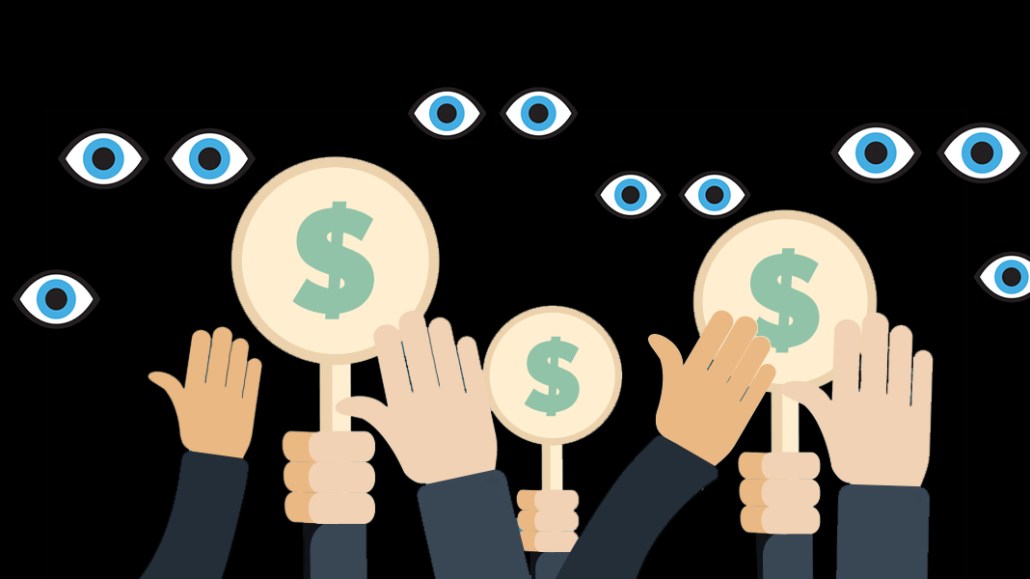Save 50% on a 3-month Digiday+ membership. Ends Dec 5.
‘A proverbial black box’: Open-exchange auctions have a transparency problem

Supply-side platforms are like the Bermuda Triangle of programmatic, where money mysteriously disappears.
The Guardian sued ad tech firm Rubicon Project last month, alleging the exchange didn’t disclose fees it charged advertisers seeking to buy the publisher’s inventory. This case shed light on two big transparency issues on the supply side: It is unclear to a demand-side platform how much of the sales price goes back to the publisher, and if a bid price in an open exchange auction is inflated, said six ad tech executives.
“The industry has been talking about transparency on the buy side a lot, but not so much on the sell side, even after the Guardian-Rubicon lawsuit,” said one demand-side executive who spoke on condition of anonymity. “The whole SSP transparency issue is impacting market dynamics.”
‘A proverbial black box’
SSPs are known to charge publishers a fee to participate in an open-exchange auction, which is outlined in the contract between the publisher and SSP. But many publishers and people on the buy side alike don’t know that SSPs also charge the demand side a fee to participate as well. Will Doherty, vp of business development for Index Exchange, an SSP, pointed out that for open-exchange auctions, there is a contract between the DSP and the SSP (or exchange) where fees charged to the media buyer are often hidden in the fine print. They can come in the form of “tech fees,” “management fees” or “buy-side fees.”
“It’s a proverbial black box,” said Doherty, adding that he thinks the exposure of the fees will eventually pressure SSPs to stop charging them. “I don’t know if those fees can survive through this year.”
In practice, let’s say a publisher uses SSP XYZ that runs an auction with several bidders. If DSP A bids $10 and DSP B bids $5 for an impression from the publisher, DSP A will win the bid with a clearing price of $5.01 for this impression. But instead of reporting back $5.01, SSP XYZ may tell the publisher, “I sold this impression at $3,” so SSP XYZ can keep $2.01 as a fee indirectly paid by DSP A.
“This is currently the normal state of things for most exchanges, where the publisher does not know the actual price paid by the DSP,” said Doherty, adding, “We are fully transparent in this regard.”
Jay Friedman, chief operating officer for programmatic agency Goodway Group, added that there’s no way for the buy side to know how much the SSP is returning to the publisher.
That publisher may also have thousands of users on its site and serve thousands of ads in that single second, making it hard to figure out which ad each side is talking about, said Friedman.
Blind auctions may create fake bids
Another blind spot DSPs have is they can’t see other bids in an auction, so they can’t tell if a bid price is inflated or not.
Blind auctions are considered the fairest way to run an auction because no single bidder has an advantage over other bidders or the publisher, said Jeffrey Hirsch, CMO for PubMatic. But in blind auctions, an SSP can throw in a fake bid to raise the clearing price and DSPs would never know, ad tech executives said.
For instance, if a DSP bids $5 for an impression through an SSP from a publisher that has a price floor of $2, and there are no other participants in the auction, the DSP is supposed to pay $2.01 for the impression. But the SSP could submit a fake bid, say, $2.50, and send the DSP a winning price of $2.51, said George Levin, CEO for Getintent.
“If SSPs are doing that to juice up the rates, there is no way to tell,” said Mani Gandham, CEO for Instinctive. “It is possible to run across different SSPs and try to compare win rates, but there are so many factors between each impression that it is not much use.”
And since DSPs are unable to identify the second-highest bidder in an auction, a trading desk that’s plugged into multiple DSPs could end up being both the winning bidder and the second-highest bidder, artificially inflating the winning price, added Mike Caprio, general manager of programmatic for Sizmek.
The solution
Publishers can set price floors to maintain some control over their revenue, but few on both the buy side and sell side fully understand what happens to prices throughout an auction. For more transparency, ad executives say media buyers and publishers could form private marketplaces or do automated guaranteed deals where pricing is negotiated as flat rate or fixed range with a minimum spend. (Those deals are typically much more expensive and have their own issues.)
Levin also believes that browser-side header bidding is the most transparent way to buy traffic. Since the bidding takes place in the browser, DSPs can see a publisher’s code and inspect the bids for a particular auction from their header partners after an auction occurs. (Of course, that doesn’t mean DSPs are able to see the bids in real time and adjust their bids accordingly.)
“With publishers moving toward server-based bidding, that transparency is lost,” said Levin.
We’ll focus more on transparency at the upcoming Digiday Programmatic Marketing Summit. Learn more here.
More in Marketing

‘AI is permeating everything we do’: How Guitar Center developed 2 AI tools this year
This summer, the company launched a chatbot called Rig Advisor to help customers find the right instruments and products.

Behind the rise of the chief productivity officer and what it means for companies and employees
The CPO is envisioned as the leader who orchestrates people and technology together to drive business outcomes.

OpenX redraws the SSP-agency relationship
The gradual realignment of programmatic’s middlemen discussed at Digiday’s Programmatic Marketing Summit.







